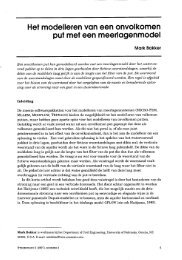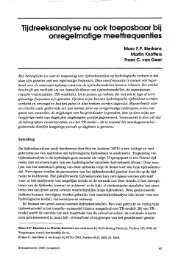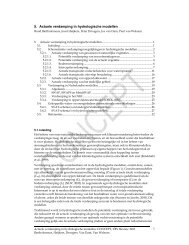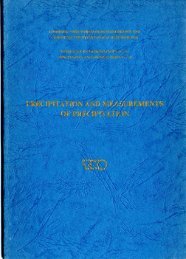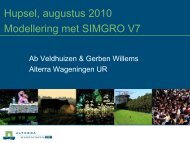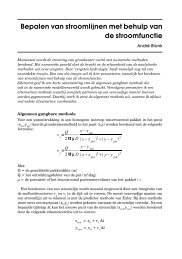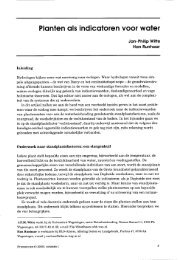Hydro-ecological relations in the Delta Waters
Hydro-ecological relations in the Delta Waters
Hydro-ecological relations in the Delta Waters
Create successful ePaper yourself
Turn your PDF publications into a flip-book with our unique Google optimized e-Paper software.
Bicropollutants (heavy metals and mganic compounds) became attaohed to<br />
<strong>the</strong> f<strong>in</strong>es <strong>in</strong> <strong>the</strong> sediment carried by <strong>the</strong> rivers, and this lea to <strong>the</strong><br />
<strong>Delta</strong> region also be<strong>in</strong>g affected by <strong>the</strong>se contam<strong>in</strong>ants. Ifowever,<br />
because of compartmsntalization. eerta<strong>in</strong> areas, namely Lake Grevel<strong>in</strong>gen<br />
and <strong>the</strong> tidal bas<strong>in</strong> of <strong>the</strong> Eastern Scheldt, escaped <strong>the</strong> wave of<br />
pollution. The qnautities of micropallutants <strong>in</strong> <strong>the</strong>se areas are very<br />
€lose to natural backgmund levels. The explanatian for this is that<br />
<strong>the</strong> compartmentalization of <strong>the</strong>se areas waa cmpleted before <strong>the</strong><br />
pollucibn <strong>in</strong> <strong>the</strong> Rh<strong>in</strong>e and Meuse reached such high levels.<br />
m contrast, <strong>the</strong> closure of <strong>the</strong> Itar<strong>in</strong>gvliet esfuary led to <strong>the</strong><br />
formation of new sedimentation areas just prior to <strong>the</strong> time at which<br />
ehe pollution <strong>in</strong> <strong>the</strong> m<strong>in</strong>e and Wuee reached a peak. Thus layers of<br />
contam<strong>in</strong>ated material have settled <strong>in</strong> <strong>the</strong>se sedimentation ar-S.<br />
30% of <strong>the</strong> tutal am~unt of silt transported by <strong>the</strong> rivers Bh<strong>in</strong>e and<br />
Meuse is depasited <strong>in</strong> <strong>the</strong>se areas.<br />
Almost<br />
Estuaries that hare mt been <strong>in</strong>fluenced by closure operations can also<br />
undergo significant tempmrary sedimentation effeots. An uample of this<br />
is <strong>the</strong> Land of Saeft<strong>in</strong>ghe <strong>in</strong> <strong>the</strong> Western Scheldt estuary. h a result<br />
of a rise <strong>in</strong> <strong>the</strong> sea level and a deepehg of <strong>the</strong> shipp<strong>in</strong>g channel, <strong>the</strong><br />
difference between low and higher water hqs <strong>in</strong>creased which. <strong>in</strong> turn,<br />
had resulted <strong>in</strong> a sigaiftcz~tLy greater deposition of silt on <strong>the</strong><br />
mudflats and salt marches. Blmosr 254: of <strong>the</strong> silt crsnspdrted by <strong>the</strong><br />
river Sehaldt settles <strong>in</strong> <strong>the</strong>se areas. Although relatively little is<br />
born about <strong>the</strong> effects that conram<strong>in</strong>ated beds haae on <strong>the</strong> aquatic<br />
ecosystem, <strong>the</strong>re are clear signs that eecelogical contmu~iities whPch &re<br />
directly dependent on <strong>the</strong> river bed environment can be disrupted. In<br />
addition, <strong>the</strong> aouots of pollutants found <strong>in</strong> Certa<strong>in</strong> organisms and<br />
plants now exceed <strong>the</strong> maximum acoeptable levels for human cm%umption.<br />
Future clean-up operations could be considered £m tbe conram<strong>in</strong>ated<br />
sedimentation areas when <strong>the</strong> level of pollutian from discharges <strong>in</strong>to<br />
<strong>the</strong> river baeiw has been sufficiently reduced. In view of th8 scale<br />
and eeent of <strong>the</strong> sedimentatim layer concsrned, no solutions have yet<br />
been fuund to this pmhlm.





